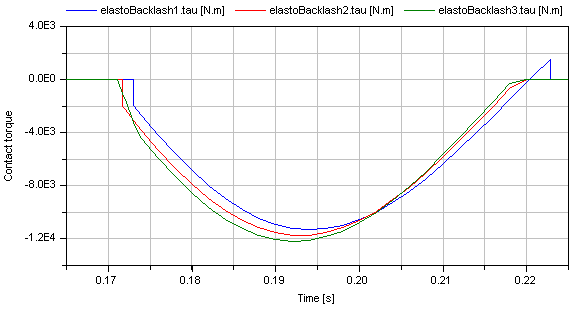This element consists of a backlash element connected in series to a spring and damper element which are connected in parallel. The spring constant shall be non-zero, otherwise the component cannot be used.
In combination with components IdealGear, the ElastoBacklash model can be used to model a gear box with backlash, elasticity and damping.
During initialization, the backlash characteristic is replaced by a continuous approximation in the backlash region, in order to reduce problems during initialization, especially for inverse models.
If the backlash b is smaller as 1e-10 rad (especially, if b=0), then the backlash is ignored and the component reduces to a spring/damper element in parallel.
In the backlash region (-b/2 ≤ flange_b.phi - flange_a.phi - phi_rel0 ≤ b/2) no torque is exerted (flange_b.tau = 0). Outside of this region, contact is present and the contact torque is basically computed with a linear spring/damper characteristic:
desiredContactTorque = c*phi_contact + d*der(phi_contact)
phi_contact = phi_rel - phi_rel0 - b/2 if phi_rel - phi_rel0 > b/2
= phi_rel - phi_rel0 + b/2 if phi_rel - phi_rel0 < -b/2
phi_rel = flange_b.phi - flange_a.phi;
This torque characteristic leads to the following difficulties:
In the literature there are several proposals to fix problem (2). However, there seems to be no proposal to avoid sticking. For this reason, the most simple approach is used in the ElastoBacklash model, to fix both problems by slight changes to the linear spring/damper characteristic:
// Torque characteristic when phi_rel > phi_rel0 if phi_rel - phi_rel0 < b/2 then tau_c = 0; // spring torque tau_d = 0; // damper torque flange_b.tau = 0; else tau_c = c*(phi_rel - phi_rel0); // spring torque tau_d = d*der(phi_rel); // damper torque flange_b.tau = if tau_c + tau_d ≤ 0 then 0 else tau_c + min( tau_c, tau_d ); end if;
Note, when sticking would occur (tau_c + tau_d ≤ 0), then the contact torque is explicitly set to zero. The "min(tau_c, tau_d)" part in the if-expression, limits the damping torque when it is pushing. This means that at the start of the contact (phi_rel - phi_rel0 = b/2), the damping torque is zero and is continuous. The effect of both modifications is that the absolute value of the damping torque is always limited by the absolute value of the spring torque: |tau_d| ≤ |tau_c|.
In the next figure, a typical simulation with the ElastoBacklash model is shown (Examples.Backlash) where the different effects are visualized:

See also the discussion State Selection in the User's Guide of the Rotational library.